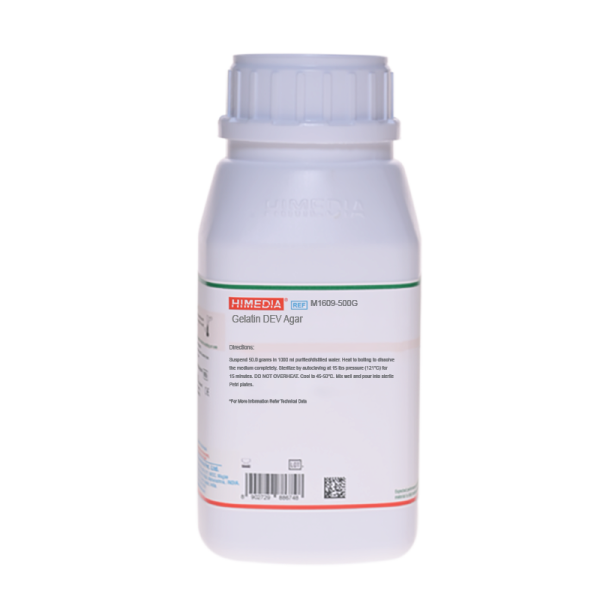 Your enquiry has been submitted
Your enquiry has been submitted
Gelatin DEV Agar is used for determining the total microbial count and detecting gelatin-liquefying microorganisms in water.
Composition**
| Ingredients | Gms / Litre |
|---|---|
| Peptone from meat | 10.000 |
| Meat extract | 10.000 |
| Sodium chloride | 5.000 |
| Gelatin | 10.000 |
| Agar | 15.000 |
Final pH ( at 25°C) 7.3±0.2
**Formula adjusted, standardized to suit performance parameters
Directions
Suspend 50 grams in 1000 ml distilled water. Mix thoroughly. Heat to boiling to dissolve the medium completely. Sterilize by autoclaving at 121°C for 15 minutes. DO NOT OVERHEAT. Cool to 45-50°C. Mix well and pour into sterile Petri plates.
Principle And Interpretation
Gelatin, a protein derivative of animal collagen is incorporated into various media to determine an organisms ability to produce proteolytic type enzyme (proteinase) detected by digestion or liquefaction of the gelatin (1). Gelatinase is a pepsin, which hydrolyses gelatin to polypeptides, peptides and amino acids. Gelatin DEV Agar is used to determine the total microbial count and for detecting gelatin liquefying microorganisms in water as per the German Drinking Water Regulations, 1990 (2).
The medium consists of nutrients like peptone from meat, meat extract and gelatin, which provide nitrogen compounds and also carbon compounds for the growth of organisms. Gelatin acts as solidifying agent and also acts as a substrate for the organisms producing gelatinase enzyme. Gelatin breakdown can be visualized by flooding the plates with a saturated solution of ammonium sulphate. Clear zones are observed around gelatin-liquefying colonies.
Quality Control
Appearance: Cream to yellow homogeneous free flowing powder
Gelling: Firm, comparable with 1.5% Agar gel and 1.0% Gelatin gel
Colour and Clarity of prepared medium: Yellowish brown coloured, clear to slightly opalescent gel forms in Petri plates
Reaction: Reaction of 5.0% w/v aqueous solution at 25°C. pH : 7.3±0.2
pH: 7.10-7.50
Cultural Response
Cultural characteristics observed after an incubation at 18-22°C for 40-48 hours.(Gelatin liquefaction is observed by flooding the plate with saturated solution of ammonium sulphate)
| Organism | Inoculum (CFU) | Growth | Recovery | Gelatin liquefaction |
|---|---|---|---|---|
| Escherichia coli ATCC 25922 | 50-100 | good-luxuriant | >=70% | negative, no clear zone |
| Pseudomonas aeruginosa ATCC 27853 | 50-100 | good-luxuriant | >=70% | positive, clear zone around the colony |
| Bacillus cereus ATCC 10876 | 50-100 | good-luxuriant | >=70% | positive, clear zone around the colony |
| Staphylococcus aureus ATCC 25923 | 50-100 | good-luxuriant | >=70% | positive, clear zone around the colony |
| Proteus vulgaris ATCC 13315 | 50-100 | good-luxuriant | >=70% | negative, no clear zone around the colony |
| Enterococcus faecalis ATCC 29212 | 50-100 | good-luxuriant | >=70% | positive, clear zone around the colony |
| Aeromonas hydrophila ATCC 7966 | 50-100 | good-luxuriant | >=70% | positive, clear zone around the colony |
Storage and Shelf Life
Store below 30°C in tightly closed container and prepared medium at 2-8°C. Use before expiry period on the label.
Reference
- MacFaddin J. F., 2000, Biochemical tests for Identification of Medical Bacteria, 3rd Edi., Lippincott, Williams and Wilkins, Baltimore.
- Deutsche Einheitsverfahren zur Wasser-, Abwasser- und Schlammuntersuchung. - VCH Verlagsgesellschaft, D-6940 Weinheim.
- Verordnung über Trinkwasser und über Wasser für Lebensmittelbetriebe vom 12, Dezember 1990, - Bundesgesetzbl.: Teil I; 2613-2669 (1990).
| Product Name | Gelatin DEV Agar |
|---|---|
| SKU | M1609 |
| Customized Product Available | No |



